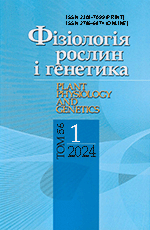In the laboratory experiment it was shown that the pre-seeding treatment of Galega orientalis seeds with silver and copper nanoaquacitrates with application of the consortium of soil-healthy microorganisms of preparation Extrakon, had a synergistic physiological effect, initiated emergence and growth of seedlings and increased oxidoreductase activity in tissues. The activity of nonspecific peroxidases and catalase in tissues increased most strongly with inoculation of shoots with phytopathogenic mycoplasma Acholeplasma laidlawii — by 71.4 and 66.7 %, respectively. With presowing treatment of seeds in a 1 % solution of silver and copper nanoaquacitrates, the activity of peroxidase and catalase increased to a lesser extent — by 35 and 36.7 %.
Keywords: Galega orientalis, silver and copper nanoaquacitrates, oxidoreductase, consortium of microorganisms, mycoplasma, A. laidlawii var. granulum str.118
Full text and supplemented materials
Free full text: PDFReferences
1. Vedmedeva, E.V. Kirpicheva, N.M. & Kobzeva, D.A. (2012). Development of methods for determining the germination of safflower seeds. Naukovo-tehnychnyi byuleten Institutu oliynyh cultur NAAN Ukrainy, No. 17, pp. 48-53 [in Russian].
2. Voskresenskaya, O.L. (2006). Great bioecology workshop: Uchebnoe posobie. Yoshkar-Ola: Izd-vo Mar. gos. un-ta. Vol. 1 [in Russian].
3. Gadzalo, Ya.M., Patyka, N.V. & Zarishnyak, A.S. (2015). Agrobiology of plant rhizosphere. Kyiv: Agrarna nauka [in Russian].
6. Medvedev, V.V., Laktionova, T.M. & Grekov, L.D. (2004). Types of estimation of dangerous phenomena in the soil cover of Ukraine. Gruntoznavstvo, 5(3,4), pp. 13-23 [in Ukrainian].
7. Miroshnichenko, O.S. (1992). Biogenesis, physiological role and properties of catalase. Biopolimery i kletka, 8(6), pp. 3-25 [in Russian]. https://doi.org/10.7124/bc.00033C
8. Oboznyiy, A.I., Yastreb, T.O. & Kolupaev, Yu.E. (2010). The effect of short-term heating on the activity and thermal stability of soluble peroxidase of wheat roots of different ecotypes. Visnik Harkivskogo natsionalnogo universitetu. Biolohiia, 2(20), pp. 61-68 [in Russian].
9. Patyka, V.P., Pasichnik, L.A. & Zhitkevich, N.V. (2016). Diseases of the Eastern goat's: monitoring, diagnosis, prevention. Vinnitsya [in Ukrainian].
10. Tokovenko, I.P. & Patyka, V.P. (2015). Mycoplasmosis of plants and their serological diagnostics. Visnik agrarnoyi nauki, No. 4, pp. 28-30 [in Ukrainian].
11. Trahtenberg, I.M. & Dmitruha, N.M. (2013). Nanoparticles of metals, methods of obtaining, scope of application, physicochemical and toxicological properties. Ukrayinskiy zhurnal z problem meditsini pratsi, 4 (37), pp. 62-74 [in Ukrainian].
12. Harchenko, O.O. (2015). Hygienic estimation of citrates of biometals obtained with the help of nanotechnologies. ( Extended abstract of Kandidat thesis). Kyiv [in Ukrainian].
13. Allen, R.G. (1991). Oxygen-reactive species and antioxidant responses during development: the metabolic paradox of cellular differentiation . Proc. Soc. Exp. Biol. Med., 196, pp. 117-129. https://doi.org/10.3181/00379727-196-43171A
14. Azooz, M.M., Abou-Elhamd, M.F. & Al-Fredan, M.A. (2012). Biphasic effect of copper on growth, proline, lipid peroxidation and antioxidant enzyme activities of wheat (Triticum aestivum cv. Hasaawi) at early growing stage. Aust. J. Crop. Sci., 6 (4), pp. 688-694.
15. Bakalova, S., Nikolova, A. & Nedeva, D. (2004). Isoenzyme profiles of peroxidase, catalase and superoxide dismutase as affected by dehydration stress and ABA during germination of wheat seeds. Bulg. J. Plant Physiol., 30, No. 1-2, pp. 64-77.
16. Bolwell, G.P. & Wojtaszek, P. (1997). Mechanisms for the generation of reactive oxygen species in plant defense — a broad perspective. Physiol. Mol. Plant Pathol., 51, pp. 347-366. https://doi.org/10.1006/pmpp.1997.0129
17. Liu, R. & Lal, R. (2015). Potentials of engineered nanoparticles as fertilizers for increasing agronomic productions . Sci. Total Environ., 514, pp. 131-139. https://doi.org/10.1016/j.scitotenv.2015.01.104
18. Luhova, L., Lebeda, A. & Hedererova, Pec.P. (2003). Activities of amino oxidase, peroxidase and catalase in seedlings of Pisum sativum L. under different light conditions. Plant Soil Environ., 49 (4), pp. 151-157. https://doi.org/10.17221/4106-PSE
19. Patyka, N.V., Bublik, N.A., Patyka, T.I. & Kitaev, O.I. ( 2014). Rhizospheric trophic chain: the role and stability in soil processes and ecosystems. Vestnik Volgogradskogo gosudarstvennogo universiteta, 10, No. 5 (14), pp. 62-67 [in Russian].
20. Pope, M.N. (1933). Catalase activity and respiration in the leaves of growing barley. J. Agric. Res., 46 (11), pp. 35-40.
21. Soto, P., Gaete, H. & Hidalgo, M.E. (2011). Assessment of catalase activity, lipid peroxidation, chlorophyll-a, and growth rate in the freshwater green algae Pseudokirchneriella subcapitata exposed to copper and zinc. Lat. Amer. J. Aquat Res., 39 (2), pp. 280-285. https://doi.org/10.3856/vol39-issue2-fulltext-9
22. Weisany, W., Sohrabi, Y., Heidari, G., Siosemardeh, A. & Chassemi-Golezani, K. (2012). Changes in antioxidant enzymes activity and plant performance by salinity stress and zinc application in soybean (Glycine max L.). Plant Omics., 5 (2), pp. 60-67.
